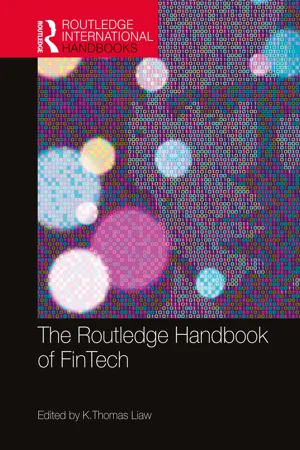![]()
![]()
FinTech is the use of financial technology to automate processes in financial services. Financial firms have been using technology to transform their businesses. FinTech will continue to be a significant force in the global financial marketplace that presents financial institutions and professionals with opportunities and challenges. As such, there has been a dramatic increase in research and publication on FinTech. The offerings of FinTech courses and FinTech programs at business schools are rising as well. The Routledge Handbook of FinTech is a comprehensive guide for students, researchers, and market professionals on the opportunities and challenges of FinTech.
The Routledge Handbook of FinTech is organised into six thematic parts and each is composed of topical and high-quality chapters. The first part covers an introduction, FinTech venture capital funding, the future of finance with respect to regulation, and the role of digital currencies in the financial system. The second part focuses on the blockchain technology applications and various aspects of cryptocurrencies. The section includes two chapters on blockchain and distributed ledger technology. In addition, two chapters provide statistical analyses on initial coin offerings. The remaining three chapters analyse price discovery in Bitcoin futures and cash markets, trading and regulation of cryptoassets, and cryptoassets in financial crime. The next part covers FinTech in banking. The chapters provide research findings in the open industry of banking, FinTech opportunities and challenges in banking, virtual banks in the Asia-Pacific region, and FinTech in China’s banking. A significant element in FinTech, payment and lending, is included in the fourth part. Coverage includes the impact of technology on consumer payment preferences, technology in lending circles, and lending risk management. The fifth part continues with several chapters on FinTech in other financial services. Empirical results and theoretical discussions are on robot advisory, municipal markets, and the real estate market. The last part discusses regulatory issues. This part begins with a chapter on the implications of machine learning on banking regulation. The following chapter discusses FinTech regulations in the USA and Canada. Part 6 concludes with a research on cryptocurrency market reactions to regulatory news.
1. FinTech innovation and trends
Chapters in the first part discuss FinTech from the broad finance perspective. The first chapter, “FinTech innovations and financial markets: An introduction,” outlines the objectives and coverage of this handbook. Chapter 2, “FinTech venture capital,” examines FinTech venture capital investments and the role of institutional factors on the international allocation of FinTech venture capital. The chapter documents a notable change in the pattern of FinTech venture capital investments around the world relative to other types of investments after the global financial crisis. The chapter shows that FinTech venture capital investments are relatively more common in countries with weaker regulatory enforcement and without a major financial center after the financial crisis. The chapter also shows the FinTech boom is more pronounced for smaller private limited partnership venture capitalists that likely have less experience with prior venture capital booms and busts. These FinTech venture capital deals are substantially more likely to be liquidated, especially when located in countries without a major financial center.
Chapter 3, “The future of finance: Why regulation matters,” explores the various challenges of regulating technology-driven change in financial services. As technology “eats the world,” it creates a plethora of new opportunities, but it also creates tremendous challenges that require some form of government intervention. In a world where agility is essential, governments are sluggish and disconnected. This creates potential risks, most obviously for the consumers of financial services. In developing answers to these regulatory dilemmas, the authors argue that traditional approaches to regulating financial services are obsolete and that new thinking is required. State actors are at an enormous informational disadvantage and lack the capacities and resources to keep up with the fast-moving actors that dominate the sector. New and more innovative approaches need to be found. The chapter describes several such approaches, including regulatory “co-creation,” policy experimentation, and technology-driven regulation (so-called RegTech).
Chapter 4, “Digital currencies: What role in our financial system?,” reviews the emergence of different forms of digital currencies and whether they fulfil a good role as currencies. To this end, the chapter also examines how and whether they might challenge traditional currencies as well as the role guardians of money, price and financial stability, namely central banks, play. Furthermore, the chapter discusses the need for central banks to also adapt by becoming more digital and to what effect.
2. Blockchain and cryptocurrencies
Chapter 5, “Decentralized autonomous risk transfer on the blockchain,” explains the functionality and operating principles of this new method of risk transfer. The chapter provides an overview of the corresponding institutional arrangement and its challenges. The chapter identifies two main challenges, namely ...
